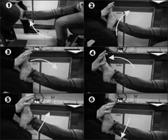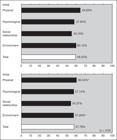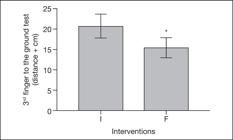ABSTRACT
BACKGROUND AND OBJECTIVES: The objective of this study was to evaluate the effect of neural mobilization technique on individuals with chronic low back pain, as well as analyze possible changes in pain, motor behavior and on cytokine quantification before and after treatment.
METHODS: Sixteen individuals with mean age of 30.45±10.32 years old were evaluated. The technique consisted of a total of 10 interventions, with a total duration of 10 minutes, divided into four series of 2 minutes each, with a 30-second interval between each series. The following outcomes were evaluated: pain intensity using the visual analog scale; mobility of the lumbar spine with the third finger to the ground test and hip goniometry; concentration of cytokines in serum with the multiplex technique; and quality of life with the Oswestry Disability Index, the Roland-Morris Disability Questionnaire and the World Health Organization Quality of Life Questionnaire-bref.
RESULTS: Results showed a reduction in pain intensity of approximately 70% between the assessments (p<0.001). Improvements in lumbar mobility of approximately 25.5% on the third finger to the ground test (p<0.04) and improvement in the hip joint angles (p<0.04) were also observed. A difference in cytokine concentrations, both pro-inflammatory (p<0.009) and anti-inflammatory (p<0.03), was also observed between the assessments.
CONCLUSION: The technique was able to reduce pain intensity and consequently increase the mobility of the volunteers. Additionally, a difference in cytokine concentration at the end of the treatment and an improvement in the individuals quality of life were observed.
Keywords:
Low back pain; Pain; Quality of life

 Effects of neural mobilization on individuals with chronic low back pain
Effects of neural mobilization on individuals with chronic low back pain Thumbnail
Thumbnail
 Thumbnail
Thumbnail
 Thumbnail
Thumbnail
 Thumbnail
Thumbnail
 Thumbnail
Thumbnail
 Thumbnail
Thumbnail
 Thumbnail
Thumbnail






